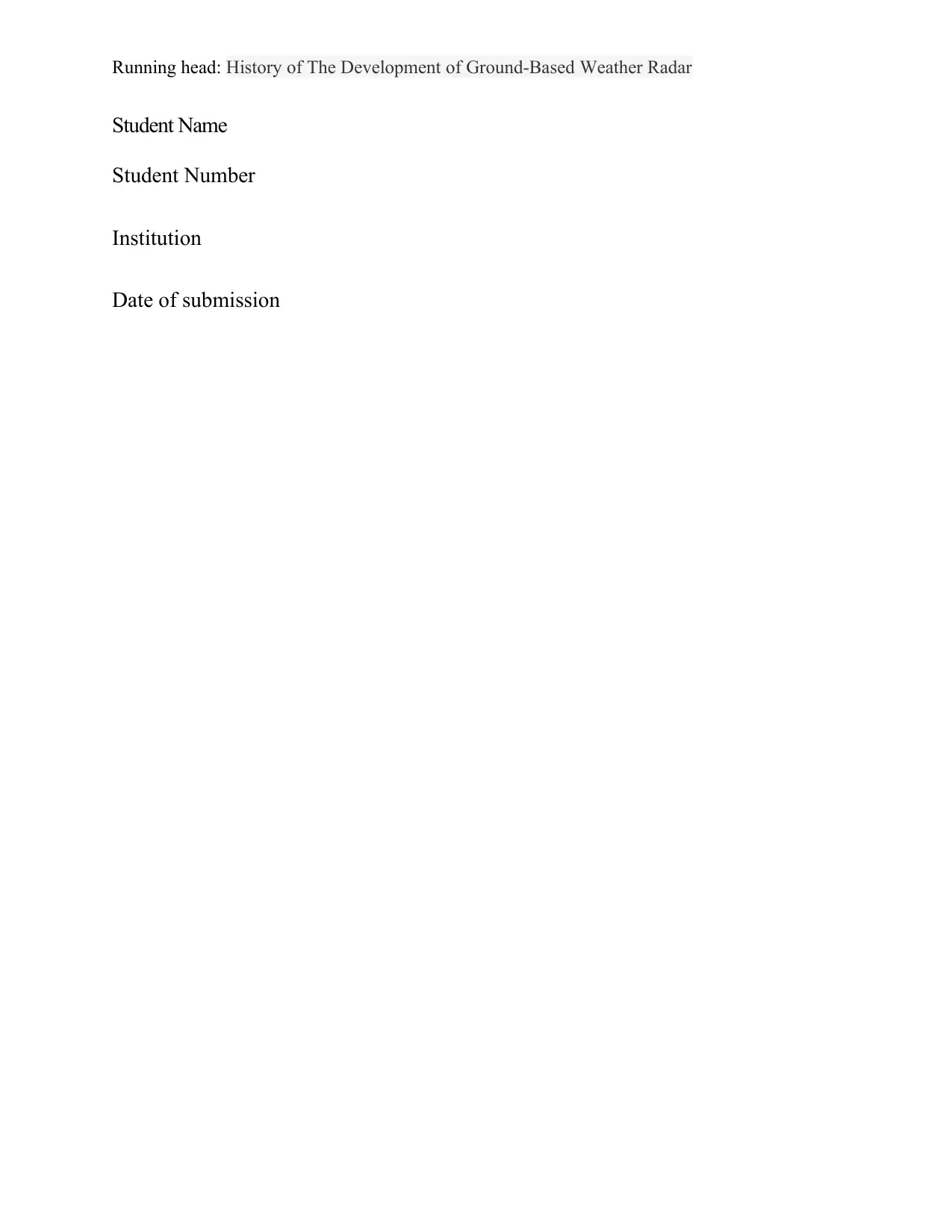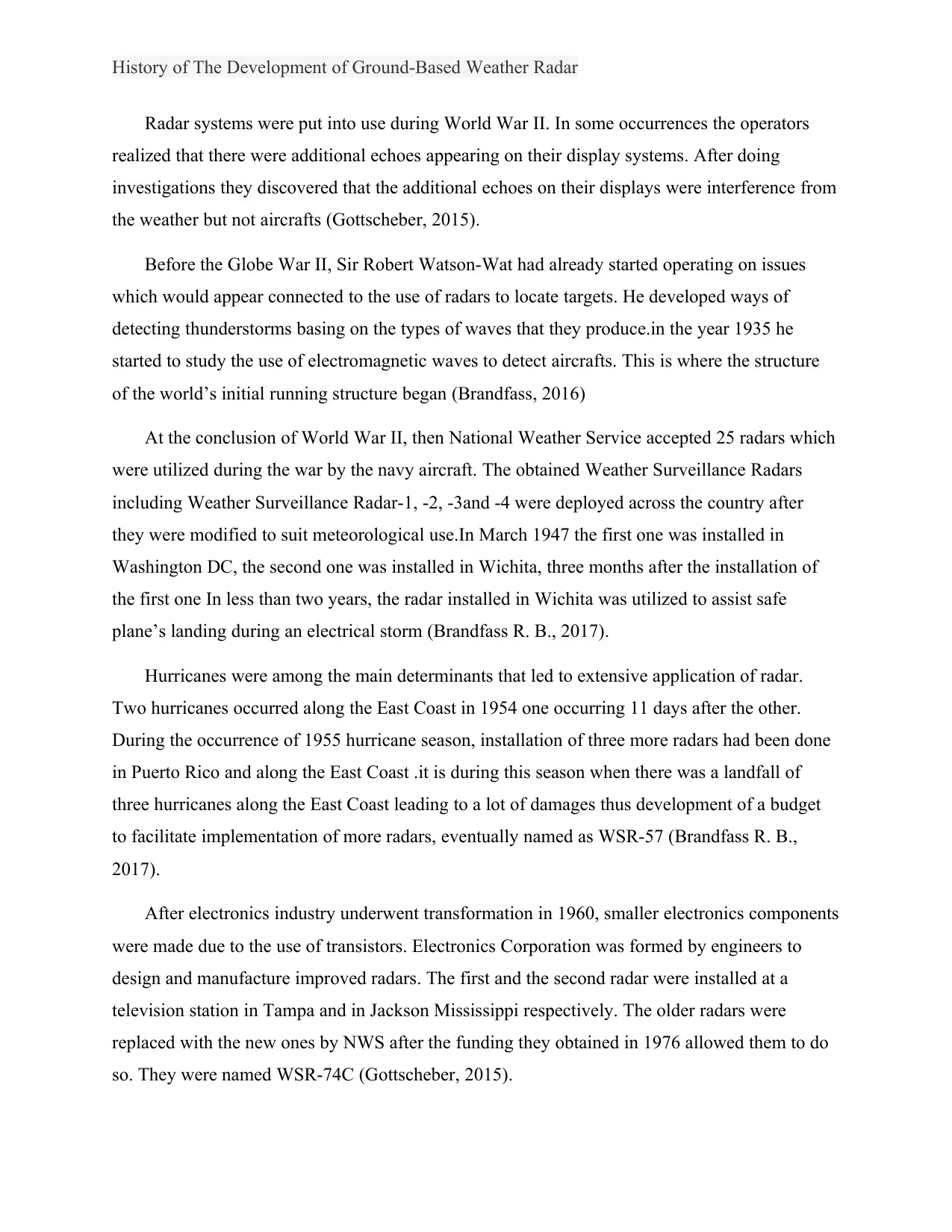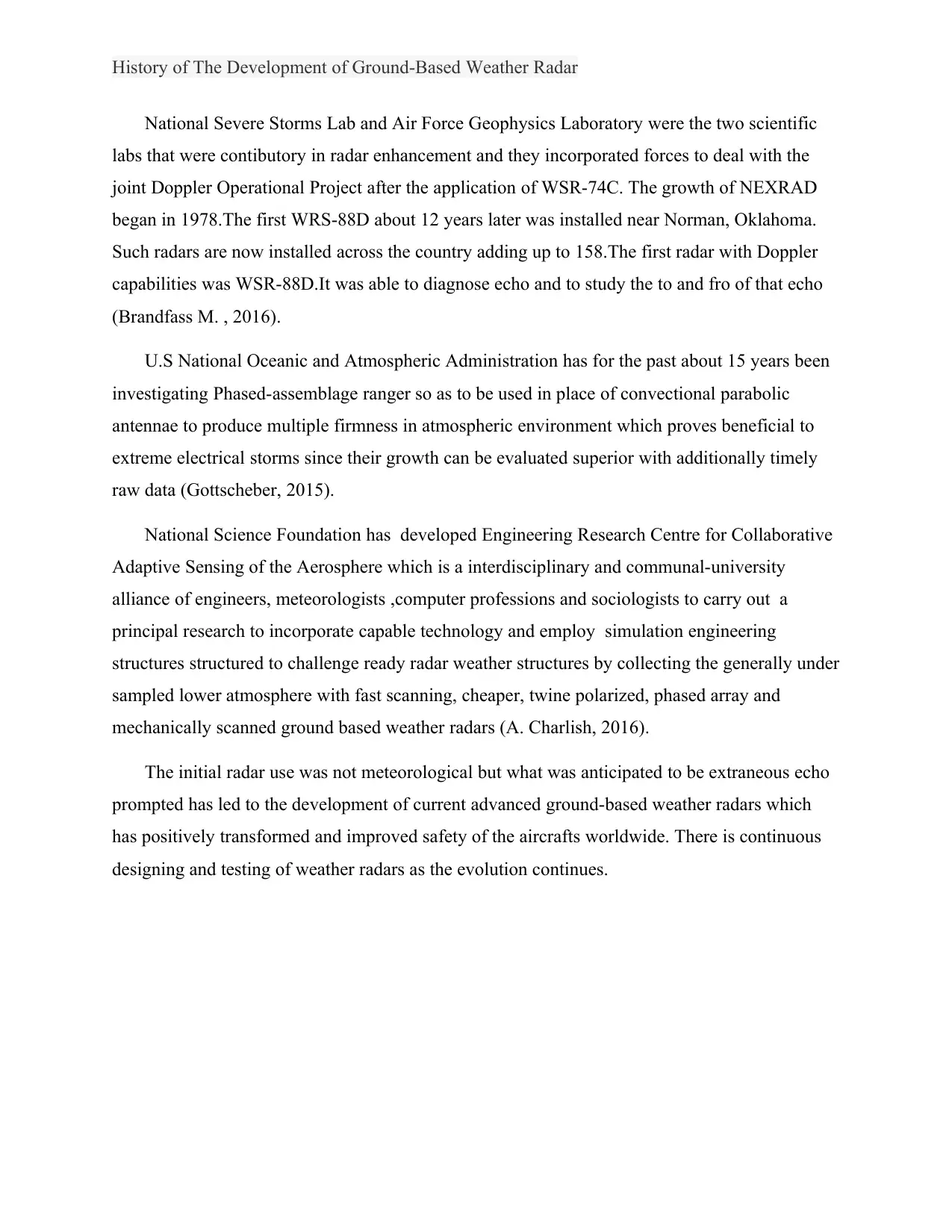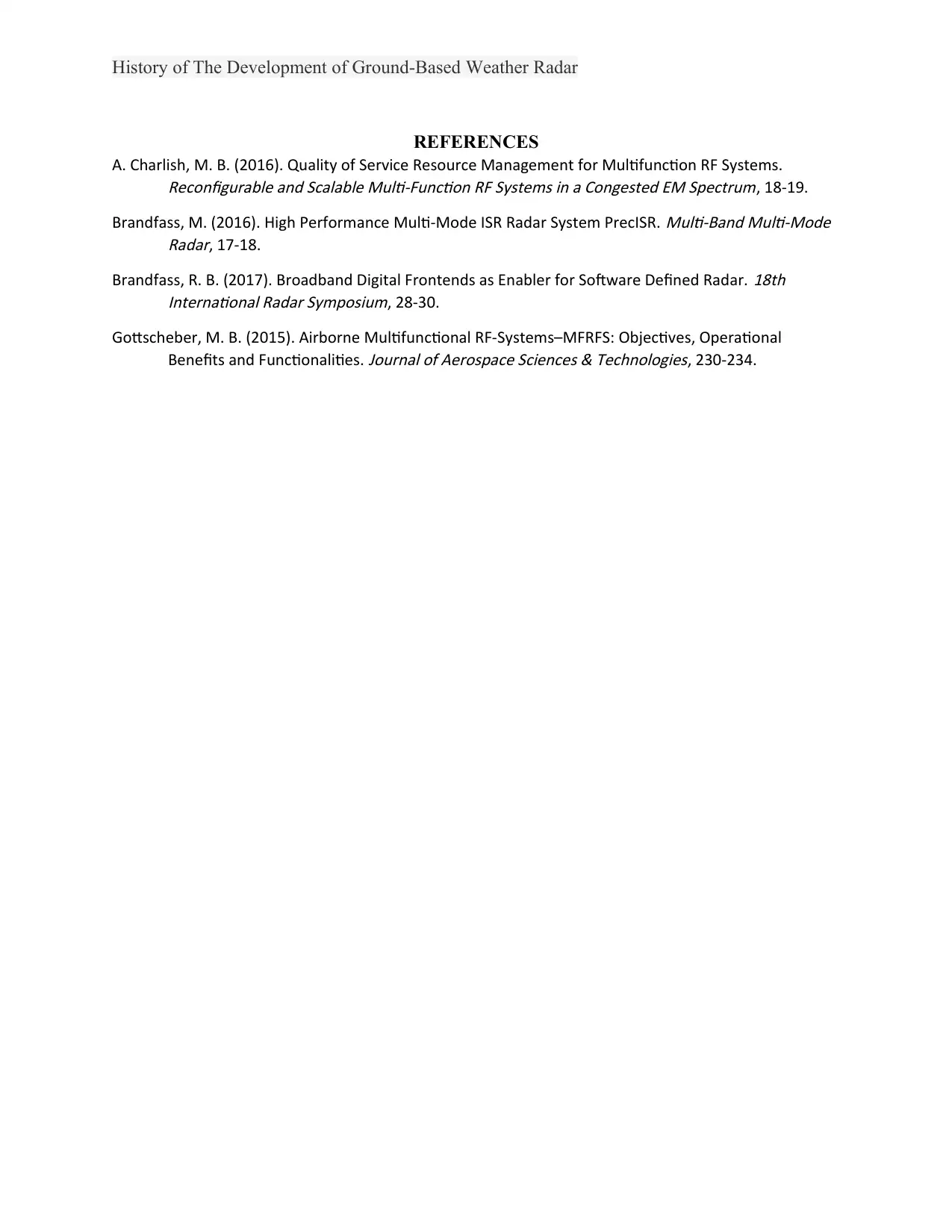Tracing the History: Development of Ground-Based Weather Radar
VerifiedAdded on 2023/05/30
|4
|886
|60
Essay
AI Summary
This essay traces the historical development of ground-based weather radar, beginning with its accidental discovery during World War II when radar operators noticed unexplained echoes caused by weather phenomena. It highlights Sir Robert Watson-Watt's early work on detecting thunderstor...

Running head: History of The Development of Ground-Based Weather Radar
Student Name
Student Number
Institution
Date of submission
Student Name
Student Number
Institution
Date of submission
Secure Best Marks with AI Grader
Need help grading? Try our AI Grader for instant feedback on your assignments.

History of The Development of Ground-Based Weather Radar
Radar systems were put into use during World War II. In some occurrences the operators
realized that there were additional echoes appearing on their display systems. After doing
investigations they discovered that the additional echoes on their displays were interference from
the weather but not aircrafts (Gottscheber, 2015).
Before the Globe War II, Sir Robert Watson-Wat had already started operating on issues
which would appear connected to the use of radars to locate targets. He developed ways of
detecting thunderstorms basing on the types of waves that they produce.in the year 1935 he
started to study the use of electromagnetic waves to detect aircrafts. This is where the structure
of the world’s initial running structure began (Brandfass, 2016)
At the conclusion of World War II, then National Weather Service accepted 25 radars which
were utilized during the war by the navy aircraft. The obtained Weather Surveillance Radars
including Weather Surveillance Radar-1, -2, -3and -4 were deployed across the country after
they were modified to suit meteorological use.In March 1947 the first one was installed in
Washington DC, the second one was installed in Wichita, three months after the installation of
the first one In less than two years, the radar installed in Wichita was utilized to assist safe
plane’s landing during an electrical storm (Brandfass R. B., 2017).
Hurricanes were among the main determinants that led to extensive application of radar.
Two hurricanes occurred along the East Coast in 1954 one occurring 11 days after the other.
During the occurrence of 1955 hurricane season, installation of three more radars had been done
in Puerto Rico and along the East Coast .it is during this season when there was a landfall of
three hurricanes along the East Coast leading to a lot of damages thus development of a budget
to facilitate implementation of more radars, eventually named as WSR-57 (Brandfass R. B.,
2017).
After electronics industry underwent transformation in 1960, smaller electronics components
were made due to the use of transistors. Electronics Corporation was formed by engineers to
design and manufacture improved radars. The first and the second radar were installed at a
television station in Tampa and in Jackson Mississippi respectively. The older radars were
replaced with the new ones by NWS after the funding they obtained in 1976 allowed them to do
so. They were named WSR-74C (Gottscheber, 2015).
Radar systems were put into use during World War II. In some occurrences the operators
realized that there were additional echoes appearing on their display systems. After doing
investigations they discovered that the additional echoes on their displays were interference from
the weather but not aircrafts (Gottscheber, 2015).
Before the Globe War II, Sir Robert Watson-Wat had already started operating on issues
which would appear connected to the use of radars to locate targets. He developed ways of
detecting thunderstorms basing on the types of waves that they produce.in the year 1935 he
started to study the use of electromagnetic waves to detect aircrafts. This is where the structure
of the world’s initial running structure began (Brandfass, 2016)
At the conclusion of World War II, then National Weather Service accepted 25 radars which
were utilized during the war by the navy aircraft. The obtained Weather Surveillance Radars
including Weather Surveillance Radar-1, -2, -3and -4 were deployed across the country after
they were modified to suit meteorological use.In March 1947 the first one was installed in
Washington DC, the second one was installed in Wichita, three months after the installation of
the first one In less than two years, the radar installed in Wichita was utilized to assist safe
plane’s landing during an electrical storm (Brandfass R. B., 2017).
Hurricanes were among the main determinants that led to extensive application of radar.
Two hurricanes occurred along the East Coast in 1954 one occurring 11 days after the other.
During the occurrence of 1955 hurricane season, installation of three more radars had been done
in Puerto Rico and along the East Coast .it is during this season when there was a landfall of
three hurricanes along the East Coast leading to a lot of damages thus development of a budget
to facilitate implementation of more radars, eventually named as WSR-57 (Brandfass R. B.,
2017).
After electronics industry underwent transformation in 1960, smaller electronics components
were made due to the use of transistors. Electronics Corporation was formed by engineers to
design and manufacture improved radars. The first and the second radar were installed at a
television station in Tampa and in Jackson Mississippi respectively. The older radars were
replaced with the new ones by NWS after the funding they obtained in 1976 allowed them to do
so. They were named WSR-74C (Gottscheber, 2015).

History of The Development of Ground-Based Weather Radar
National Severe Storms Lab and Air Force Geophysics Laboratory were the two scientific
labs that were contibutory in radar enhancement and they incorporated forces to deal with the
joint Doppler Operational Project after the application of WSR-74C. The growth of NEXRAD
began in 1978.The first WRS-88D about 12 years later was installed near Norman, Oklahoma.
Such radars are now installed across the country adding up to 158.The first radar with Doppler
capabilities was WSR-88D.It was able to diagnose echo and to study the to and fro of that echo
(Brandfass M. , 2016).
U.S National Oceanic and Atmospheric Administration has for the past about 15 years been
investigating Phased-assemblage ranger so as to be used in place of convectional parabolic
antennae to produce multiple firmness in atmospheric environment which proves beneficial to
extreme electrical storms since their growth can be evaluated superior with additionally timely
raw data (Gottscheber, 2015).
National Science Foundation has developed Engineering Research Centre for Collaborative
Adaptive Sensing of the Aerosphere which is a interdisciplinary and communal-university
alliance of engineers, meteorologists ,computer professions and sociologists to carry out a
principal research to incorporate capable technology and employ simulation engineering
structures structured to challenge ready radar weather structures by collecting the generally under
sampled lower atmosphere with fast scanning, cheaper, twine polarized, phased array and
mechanically scanned ground based weather radars (A. Charlish, 2016).
The initial radar use was not meteorological but what was anticipated to be extraneous echo
prompted has led to the development of current advanced ground-based weather radars which
has positively transformed and improved safety of the aircrafts worldwide. There is continuous
designing and testing of weather radars as the evolution continues.
National Severe Storms Lab and Air Force Geophysics Laboratory were the two scientific
labs that were contibutory in radar enhancement and they incorporated forces to deal with the
joint Doppler Operational Project after the application of WSR-74C. The growth of NEXRAD
began in 1978.The first WRS-88D about 12 years later was installed near Norman, Oklahoma.
Such radars are now installed across the country adding up to 158.The first radar with Doppler
capabilities was WSR-88D.It was able to diagnose echo and to study the to and fro of that echo
(Brandfass M. , 2016).
U.S National Oceanic and Atmospheric Administration has for the past about 15 years been
investigating Phased-assemblage ranger so as to be used in place of convectional parabolic
antennae to produce multiple firmness in atmospheric environment which proves beneficial to
extreme electrical storms since their growth can be evaluated superior with additionally timely
raw data (Gottscheber, 2015).
National Science Foundation has developed Engineering Research Centre for Collaborative
Adaptive Sensing of the Aerosphere which is a interdisciplinary and communal-university
alliance of engineers, meteorologists ,computer professions and sociologists to carry out a
principal research to incorporate capable technology and employ simulation engineering
structures structured to challenge ready radar weather structures by collecting the generally under
sampled lower atmosphere with fast scanning, cheaper, twine polarized, phased array and
mechanically scanned ground based weather radars (A. Charlish, 2016).
The initial radar use was not meteorological but what was anticipated to be extraneous echo
prompted has led to the development of current advanced ground-based weather radars which
has positively transformed and improved safety of the aircrafts worldwide. There is continuous
designing and testing of weather radars as the evolution continues.

History of The Development of Ground-Based Weather Radar
REFERENCES
A. Charlish, M. B. (2016). Quality of Service Resource Management for Multifunction RF Systems.
Reconfigurable and Scalable Multi-Function RF Systems in a Congested EM Spectrum, 18-19.
Brandfass, M. (2016). High Performance Multi-Mode ISR Radar System PrecISR.
Multi-Band Multi-Mode
Radar, 17-18.
Brandfass, R. B. (2017). Broadband Digital Frontends as Enabler for Software Defined Radar.
18th
International Radar Symposium, 28-30.
Gottscheber, M. B. (2015). Airborne Multifunctional RF-Systems–MFRFS: Objectives, Operational
Benefits and Functionalities.
Journal of Aerospace Sciences & Technologies, 230-234.
REFERENCES
A. Charlish, M. B. (2016). Quality of Service Resource Management for Multifunction RF Systems.
Reconfigurable and Scalable Multi-Function RF Systems in a Congested EM Spectrum, 18-19.
Brandfass, M. (2016). High Performance Multi-Mode ISR Radar System PrecISR.
Multi-Band Multi-Mode
Radar, 17-18.
Brandfass, R. B. (2017). Broadband Digital Frontends as Enabler for Software Defined Radar.
18th
International Radar Symposium, 28-30.
Gottscheber, M. B. (2015). Airborne Multifunctional RF-Systems–MFRFS: Objectives, Operational
Benefits and Functionalities.
Journal of Aerospace Sciences & Technologies, 230-234.
1 out of 4
Your All-in-One AI-Powered Toolkit for Academic Success.
+13062052269
info@desklib.com
Available 24*7 on WhatsApp / Email
![[object Object]](/_next/static/media/star-bottom.7253800d.svg)
Unlock your academic potential
© 2024 | Zucol Services PVT LTD | All rights reserved.